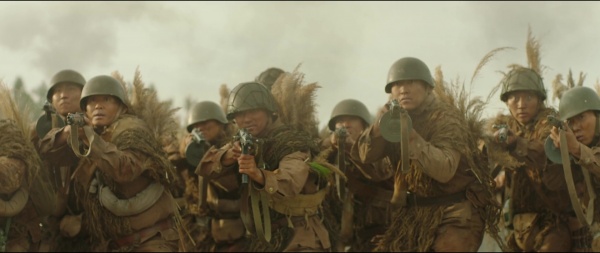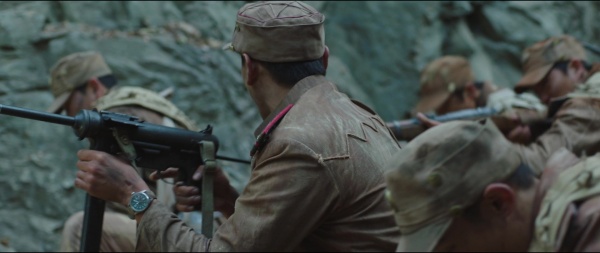Recently I watched the movie “Battle of Jangsari”, set in the Korean War.
I enjoyed it, and many of my readers may do so too.
So as not to spoil your enjoyment, I will try to avoid any possible spoilers that I can in the following passages.
The photo below shows the North Korean troops that are sent as reinforcements. Notable on their first appearance is the bundles of grass/straw/rushes that each infantryman has sprouting from his back.

At first glance I thought this might be an earlier example of the device described as in a previous post as the Vietnamese Camo Ring.
Subsequent scenes show the foliage attached directly to their shirt/blouses.
The intention is the same, however. If an enemy aircraft had appeared these infantrymen would disappear.
“Osprey Men-at-Arms 174: The Korean War 1950-53” includes the following passage (p.37) on the North Korean summer field uniform:
“The uniform had reinforcing patches on the elbows, trouser seat and knees, and frequently single or double rows of horizontal ‘zigzag’ stitching around the cap and across the shoulders, chest and upper sleeves, which were used to hold leaf camouflage. ”

For some of the movie the South Korean (ROK) soldiers wear captured North Korean uniforms.
They do not use camouflage materials, but the means by which they can be attached are clearly seen in some shots. In these examples the “stitching” appears to be relatively substantial cord.

A side view of foliage attached to a machine-gunner’s back.
Some North Korean troops also have foliage attached to their upper arms, although the means of doing this is not clear in the film. Presumably loops might also be sew to the sleeves.
Many of the North Korean soldiers are also wearing short capes of what appears to be camouflage net.
In the movie this was not clear and appeared as an irregular shape of mossy green-grey on the upper chest. In the stills this is much more clearly seen to be net.
The Russian-style shoulder-boards worn with the North Korean uniforms appear fairly impractical. Men-at-Arms 174 notes that these shoulder-boards tended to fade less than the rest of the uniform, making them stand out as regular shapes and thus detrimental to camouflage.
Also note that none of the actors have camouflaged their helmets, leaving a distinctive, recognizable shape.
As I have pointed out in recent posts, shape disruption and texture contribute far more to camouflage than colour.
Notable in this movie is that the North Korean uniforms work far better in the terrain shown than the green American fatigues worn by some characters.
The Osprey publication states that the North Korean summer field uniforms was “olive khaki shade faded rapidly to a light yellowish hue”. Actual appearance varies in the photos since the soldiers of both sides get realistically dirty.
Minor spoiler follows:
In one scene the first sergeant stamps on a mine several times and chides the student soldiers, telling them it is an anti-tank mine and ten of them could run across it without setting it off.
This is not strictly true.
The mine shown is an American M15 that is claimed to need a force 159 to 340 kg (350 to 750 lb) on pressure plate to set it off.
“Taming the Landmine” (p.51) by Peter Stiff describes how repeated passages over an anti-tank mine would “settle” the trigger mechanism of some models until they became sensitive enough to be set off by a pedestrian, donkey cart or bicycle tire.
As an aside, in “Vietnam War Booby Traps”(Elite 236) by Gordon L. Rottman, p.25 the author notes he has been unable to find any real world mine that activates when someone removes their foot, as usually shown in movies.